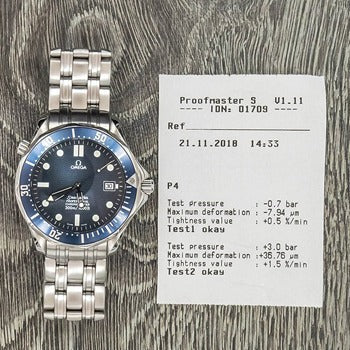How To Keep Your Watch Running for Years

A fine mechanical watch is a triumph of engineering, and a true work of art. Maybe you just bought your first mechanical watch, or perhaps you’ve had one (or more!) for a while. Perhaps you only wear it on special occasions, or maybe you wear it every day. Regardless, you should know everything there is to know about how to keep it running for years, if not decades, preserving its value. With the right care, your watch could very well outlive you. Read on to learn how to give your watch the care it deserves!
How a Mechanical Watch Works
The basic way that a mechanical watch works hasn’t changed for hundreds of years. This is part of what makes them so incredible. Unlike a quartz watch, which uses a battery, a mechanical watch has no battery, microchip, or circuitry. It gets its power from the slow unwinding of a tightly-coiled spring called the mainspring. This spring provides power to the movement as well as any additional complications the watch may have, such as a date indicator.
Watch parts are machined to near perfection at microscopic sizes and tolerances and can produce highly accurate time. The escapement assembly ensures that the power released from the mainspring is let out in reliable increments. The gears that connect the mainspring and escapement turn at various speeds. This is what allows the watch to keep and show the time.
There are two main things to watch out for that could be disruptive to a watch movement: friction and external shocks. To cope with friction, a watch should be regularly lubricated. The watch also features jeweled bearings. In the old days, they would be jeweled with real rubies. These days, however, synthetic rubies are used. The pivots of the gear wheels go in the center of these rubies. As the rubies are polished, they provide a surface that’s nearly frictionless. To cope with external shocks, the jewels are held inside a floating frame. This protects the delicate pivots of the gear wheels.
Winding a Watch
A traditional mechanical watch requires owner interaction for it to work. On most watches, the mainspring will only keep its energy for a day or so, and then the watch needs winding again. The mainspring is wound by turning the crown a few dozen times. While the process seems simple enough, there are some things to watch out for:
First, take the watch off your wrist before winding it. When the watch is on your wrist, the angle is not ideal, which can put stress on the winding stem. Also, never overwind your watch. When you can’t turn the crown anymore, and you feel the resistance, stop immediately. For optimum results, wind your watch every day. This is because the mainspring usually works best when it’s at more than half tension. Most watches will keep power for a couple of days, so it’s a good habit to wind your watch before you put it on each morning.
If you have an automatic watch, known as a self-winding watch, then the above two paragraphs don’t apply to you. The mainspring of a self-winding watch should keep its tension. This is due to the weighted rotor in the movement that oscillates with the motion of your arm. To prevent overwinding, a slipping clutch is inside.
If you wear your watch every day, then you shouldn’t need to wind your watch. If you do need to wind the watch, just turn the crown 20-30 times until you see the second hand moving, then set the time and start wearing it again. While you can’t overwind a self-winding watch, be careful as the winding mechanism is usually more fragile than that in a regular mechanical watch.
Setting a Watch
Setting a mechanical watch is pretty self-explanatory, but there are a couple of things to watch out for if your watch displays the date. One thing to remember is that you shouldn’t set the date if the time on the watch is between 9 p.m. and 2 a.m. If you have a watch that’s stopped running and you’re not sure when it stopped, pull out the crown and turn it until you see the date change. That will tell you the watch is at midnight. Then, push the time past 2 a.m. before attempting to change the date. The reason for this is because the mechanism that changes the date starts to engage the gear train after 9 p.m. and it’s only after 2 a.m. that it disengages. Therefore, if you set the date during these hours, you could break the teeth of the mechanism, which would be quite expensive to fix. Another thing to remember about setting a watch is that it’s better to move time forward than backward. This is also to prevent any harm from coming to the date mechanism.
About Water Resistance
There are three main enemies of a mechanical watch: magnets, shock, and moisture. Thankfully, these days most watches can handle all three reasonably well. Most mechanical watches are water resistant to about 30 meters. While 30 meters might sound like a lot, keep in mind that that’s the minimum rating for a watch. So while your watch might survive if you accidentally drop it in water, it’s best to avoid taking it swimming regularly. For that kind of application, you’d want a water resistance rating of at least 50 meters. If you regularly take your watch into water, you should have the water resistance tested every year by a professional, as it may need to have its gaskets replaced.
About Shock Resistance
Your watch contains shock absorbers to protect it from an unexpected fall or other physical disturbances. There are limits however—remember that your watch is a delicate mechanism that requires precision in order to operate properly. Certain activities, such as tennis or golfing, put extra stress on a mechanical watch. On days that you’ll be doing an activity that involves extreme jolts of force, you may want to wear a quartz watch.
About Magnetism
Magnetism can cause problems with a mechanical watch. It can cause the spirals of the mainspring to push together, making the spring shorter. This causes the watch to run much faster than normal. While a lot of progress has been made regarding the protection of watches from magnetism, the mainspring is still vulnerable. Magnets are in a lot of electronics such as TVs, speakers, and iPads. If your watch gets close to them, it may not keep time accurately. If your watch is suddenly showing a time that’s ahead by a few minutes, chances are it was exposed to magnets. While a watch can easily be demagnetized by a professional, it’s even better to avoid the magnetism in the first place.
Polishing Crystal
These days, most watches use sapphire crystals that are scratch-resistant. Some watches, however, use acrylic crystals that are easily scratched. Thankfully, they can also be polished easily. You could use a product called Polywatch, which is specifically designed for this task, although other products such as Brasso or even car headlamp lens cleaner can do the job.
Case Care
Watch cases can also get scratched, but thankfully they can also be polished. A watch polishing kit comes with abrasive cloths that can help you restore the finish of your watch case. Some claim to have had success using a Scotchbrite pad, but your mileage may vary. If you have a collectable vintage watch, remember that the original unpolished condition might be more desirable. If you plan to sell it, it may be better to just tolerate the scratches.
Cleaning Your Watch
Your watch will gather sweat, skin, hair and other junk from your wrist as you wear it. Therefore, it’s necessary to clean it now and again. Using an old toothbrush (not a new one, as the bristles will be too firm) and some running water, clean the back of the case and around the lugs of the strap.
Watch Straps
Straps and bracelets can maintain their look with a bit of regular care. Rubber straps are great for water, but can deteriorate from sun exposure and getting hit with products such as sunscreen, bug spray or cologne. Therefore, it’s important to check them regularly, especially around the buckle and springbars. You don’t want your precious watch to fall off its strap when you least expect it!
Leather straps aren’t ideal for water, but leather oils and waterproofing products can help make them last longer. A metal bracelet, however, can last as long as your watch, and just needs some regular polishing. Regardless of which type of strap you use, it’s likely worth investing in a few extra springbars, as well as a strap-changing tool, so you can easily switch from one strap to the other.
Professional Maintenance
Your watch contains lubricating oils, gear teeth, and jewels. These can dry up or wear out over time, leading to very costly repairs. To avoid this, every few years your watch should be sent to a professional for maintenance, in order to maintain its value.
Conclusion
So, there you have it! Your watch is an investment that could very well outlast you. Simply follow these tips to keep it in good shape and running for as long as possible.
